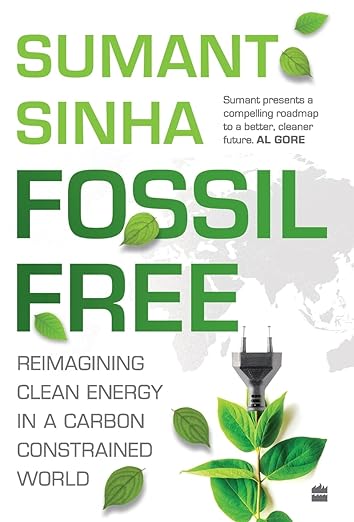Book Summary by Sanyukta Chougale, Senior Research Intern, EECC
Fossil Free: Reimagining Clean Energy in a Carbon Constrained World is a thought-provoking book by Sumant Sinha, Founder Chairman and CEO of ReNew, India’s first Nasdaq-listed renewable energy company offering decarbonisation solutions.
A first-generation entrepreneur, the author is an ardent advocate for climate action and sustainable development. He writes and speaks on these topics and is associated with international organisations such as the World Economic Forum and UNFCCC COP, and global universities.
In the book, he narrates the story of the global transition towards renewable energy away from fossil fuels, and provides a comprehensive analysis of the energy landscape and the challenges and opportunities associated with energy transition, with particular focus on India. He explores the interplay between policy, technology and market forces. The book underscores the pivotal role India can play in the global energy transition. Sinha is optimistic about the imminent rise of renewable technology that will mitigate the devastating impacts of climate change.
Fossil Free begins by illustrating the glaring realities of climate change, with recent instances of disappearing glaciers, raging bushfires, incessant rainfalls, and devastating hurricanes. It explains the connection between climate change, food shortage, water scarcity, energy crisis, and financial challenges. The examples of the Arab Spring and the Venezuelan crises elucidate the intensity and interconnectedness of climate change and political upheavals.
The book illustrates two major energy transitions in the world — from wood and bioenergy to coal, and from coal to oil. It gives a chronological account of the inventions of coal-powered steam engines, gasoline-fired automobiles, and oil-powered warships that not only replaced manual labour but also played a crucial role in developing economies of the UK, USA, and other countries, and in shaping global politics. A chapter in the book is devoted to the story of electricity, its invention, and how it shaped other industries.
The author explains how fossil fuels cause climate change and pollution. He explains the process of global warming, the greenhouse effect, and feedback loops. He also dwells on pollutants like lead, NOx, SOx and VOCs and its harmful effects on individual as well as environmental health. Moreover, he asserts that mitigating air pollution is easier and quicker to achieve than mitigating climate change. He highlights the equity issue of global climate change and claims that the window to address these problems is closing.
The book talks about the actions taken by China, India, Germany, UK, USA, and other major countries, and international organisations such as OECD (Organisation for Economic Co-operation and Development) to combat climate change and to facilitate the transition towards renewables. The author notes that reducing carbon emissions, from the perspective of less industrialised countries, is unfair, unjust and discriminatory.
The author also highlights how SDG7 — of creating access to ‘affordable, reliable, modern, renewable and sustainable energy’ — enables the fulfilment of other SDGs. Additionally, he gives an outline of innovations in charging and discharging processes that have resulted in reduced grid service costs and increased storage capacity of solar and wind power.
The second half of the book covers the significant progress made in India in renewable energy and what more is required to fulfil India’s ambitious clean energy targets by 2030. It explores the solar and wind energy sectors in detail and explains how tax incentives, subsidies, competitive bidding and government schemes like National Solar Mission helped proliferate the wind and solar sector. It explains why China has become a major hub for solar PV manufacturing, and showcases bottlenecks in the renewables industry in India, like poor DISCOM health, inadequate grid infrastructure, grid intermittency, political instability and lack of capital.
One chapter is dedicated to articulate how solar rooftops are an excellent clean energy solution for common people. With distributed energy resources like rooftop solar panels, electricity consumers can become electricity producers and enable a ‘smart grid of the future’. The author’s imaginative consumer experience in this smart grid of the future gives an insight into the harmonious integration of renewable energy, paving the way for sustainable and elevated living standards. He also explains how to overcome the naturally variant characteristics of sunshine and wind speed to produce uninterrupted electricity supply.
The book spotlights the swift rise of electric vehicles in India and its thriving business potential. It dives deep into the EV sector, from steps taken by the Indian government to unit economics and demystifying the fears around EVs’ range and charging time.
Overall, the book presents a compelling case for the urgency of transitioning away from fossil fuels and offers practical insights for achieving a cleaner and more sustainable energy future. With the cost of renewable energy now becoming more competitive with coal power, the renewable energy sector not only promises environmental rejuvenation but also economic viability. Fossil Free is not just a book; it’s a call to action, urging us all to embrace renewable energy for a greener, sustainable and more equitable future.

